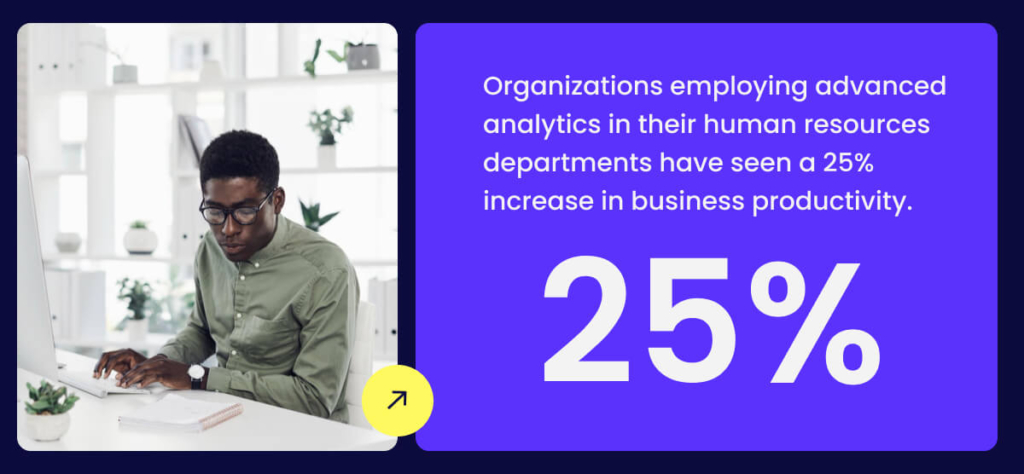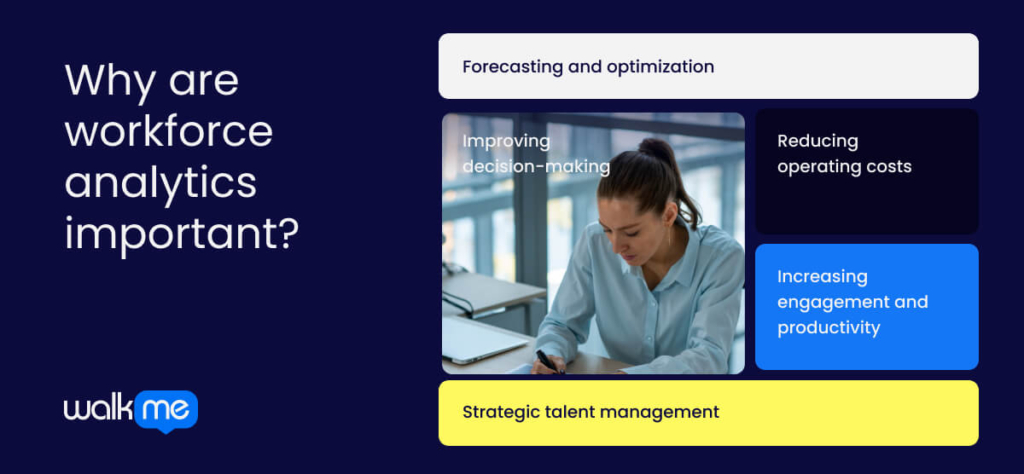Workforce analytics is reshaping how organizations manage their teams by using data to make informed decisions.
Organizations employing advanced analytics in their human resources departments have seen a 25% increase in business productivity.

Using digital tools to analyze workforce data, companies can increase productivity, reduce bias, improve engagement, and optimize workforce resources.
This guide provides a straightforward overview, explores the benefits, and offers practical insights into workforce analytics.
What are workforce analytics?
Workforce analytics is the practice of using data analysis to understand and improve company workforce management. Employee data collected from digital tools allows managers, leaders, and decision-makers to discover insights into performance, engagement, and productivity.
These insights help leaders make key hiring, retention, training, and development decisions.
Unlike traditional HR metrics, which provide limited snapshots, workforce analytics uses current data and predictive models to gain a deeper insight into workforce trends.
It is especially beneficial for managers, department heads, and top executives aiming to maximize team performance and ensure workforce strategies match overall business objectives.
Why are workforce analytics important?

Workforce analytics helps align employee efforts with broader business goals. Let’s explore it’s impact:
Forecasting and optimization
Understanding workforce needs and trends allows for more effective resource allocation. This is crucial in fast-paced industries where quick adaptation is necessary.
Improving decision-making
Analytics removes the guesswork from decisions. By understanding performance trends and skill gaps, you can make smarter choices that support sustainable workforce management.
Reducing operating costs
Analyzing data helps streamline processes and allocate resources more effectively. Identifying inefficiencies can lower costs and improve productivity.
Increasing engagement and productivity
By understanding what drives employee engagement, you can create work environments that enhance job satisfaction and performance.
Strategic talent management
Analytics helps recruit and retain talent by revealing effective strategies and supporting targeted development plans.
How are workforce analytics used?
Workforce analytics is used across all business functions to turn employee data into actionable insights that improve decision-making and drive operational success.
By analyzing employee roles, performance, and engagement data, HR teams can make strategic adjustments that address immediate workforce needs and support long-term organizational goals.
Let’s explore how workforce analytics can be used within organizations:
Predictive workforce planning
Use historical data and trends to forecast future staffing needs. Predictive analytics helps ensure you have the right talent at the right time, reducing the risk of staffing shortages or surpluses.
Real-time resource allocation
With real-time analytics, you can continually assess staffing needs, allowing you to adapt to changes and maintain operational efficiency quickly.
Proactive retention strategies
Identify patterns that lead to employee turnover. By addressing these early, you can create a better work environment to retain talent.
Employee performance tracking
Monitor individual performance metrics through performance frameworks and designated tools to understand each employee’s strengths and areas for improvement. This supports personalized feedback and performance management.
Succession planning
Workforce analytics supports succession planning by tracking skill development and career progression. This data identifies high-potential employees and allows organizations to ensure smooth transitions and maintain continuity and stability.
What are the different types of workforce analytics?
Workforce analytics can be categorized into different types, each offering unique insights to improve organizational efficiency.
These analytics types help leaders analyze past performance, predict future needs, identify problem areas, and implement real-time adjustments to optimize the workforce. They include:
Descriptive workforce analytics
Descriptive analytics focuses on historical data, helping organizations understand past workforce trends and performance. This analysis offers a baseline for evaluating future strategies.
For example, review employee turnover rates over the past year to identify seasonal patterns or high-risk departments.
Predictive workforce analytics
Predictive analytics uses historical data to forecast future workforce needs and trends. By anticipating challenges, companies can prepare, ensuring a stable and responsive workforce.
For instance, predictive analytics can help forecast staffing needs during peak business periods, allowing you to plan recruitment or training proactively.
Prescriptive workforce analytics
Prescriptive analytics suggests actions to improve outcomes by evaluating multiple scenarios. These actions help guide decision-makers on the most effective ways to optimize workforce performance.
An example might be recommending specific training programs based on skill gaps identified within teams, which can help enhance productivity and employee satisfaction.
Diagnostic workforce analytics
Diagnostic analytics identifies the root causes of workforce issues, allowing leaders to pinpoint specific areas for improvement and address underlying problems efficiently.
For example, if employee engagement scores drop, diagnostic analytics can help you trace the issue to factors such as workload, management styles, or resource allocation.
Real-time analytics
Real-time analytics monitors current workforce metrics, enabling agile responses to immediate needs. This approach supports quick decision-making in dynamic environments, improving operational agility.
For instance, real-time analytics can alert HR when absenteeism spikes in a department, allowing managers to address potential workload or morale issues immediately.
What are the benefits of workforce analytics?
Implementing workforce analytics offers organizations numerous advantages, from improving efficiency to strengthening hiring and retention strategies. By leveraging data, companies can optimize resources and build a more engaged and effective workforce.
Let’s explore these benefits in more detail:
Enhanced operational efficiency
Workforce analytics helps streamline processes by identifying inefficiencies and recommending improvements.
For example, it might reveal that certain tasks are being duplicated across departments, allowing managers to reassign responsibilities and improve productivity.
Improved talent acquisition
Analytics refines recruitment efforts by identifying candidates who align well with the organization’s needs.
For instance, it can highlight the characteristics of high-performing employees, enabling HR to target similar profiles during the hiring process.
Increased employee retention
Workforce analytics can help with employee retention by uncovering factors contributing to turnover. This allows organizations to take proactive measures to improve employee satisfaction.
For example, it might reveal that employees are leaving due to limited career advancement opportunities, prompting the development of targeted growth programs.
Data-driven workforce planning
Analytics supports strategic resource allocation, ensuring the right people are in the right roles and preventing issues with over- or understaffing.
For example, workforce planning data can help HR anticipate seasonal staffing needs, improving readiness for peak periods.
Compliance and risk management
Workforce analytics allows companies to monitor compliance and manage risks effectively. For example, analytics can flag departments with irregular overtime patterns, helping HR ensure adherence to labor laws and reduce regulatory risks.
Workforce analytics in different industries
Workforce analytics benefits a wide range of industries by addressing unique needs and improving workforce management. Here’s how various sectors apply analytics to enhance efficiency and outcomes.
Education sector
In education, data insights support both student and staff experiences. Schools and universities use analytics to assess staffing needs, guide faculty development, and allocate resources effectively, creating a richer learning environment.
Economic and workforce development
Regional organizations apply analytics to support economic growth. By examining labor market trends, they can identify skill gaps, forecast job demand, and develop training programs that strengthen the local talent pool.
Healthcare
Analytics optimize staff allocation, balance workloads, and enhance patient care quality in healthcare. Hospitals use these insights to ensure appropriate staffing levels, benefiting employee well-being and patient outcomes.
Retail
The retail sector uses analytics to manage seasonal demand fluctuations. By analyzing historical data, retailers can adjust staffing levels for peak periods, meeting customer needs efficiently without overstaffing during slower times.
How can organizations implement workforce analytics?
Implementing data-driven workforce strategies requires a structured approach to align analytics initiatives with organizational goals. By following these steps, organizations can integrate analytics into workforce management effectively, improving operations and employee satisfaction.
Define business goals
The first step is to identify specific workforce-related objectives. Aligning data efforts with business priorities ensures that insights are actionable and support essential goals, such as improving productivity, reducing turnover, or increasing engagement.
Establish key performance indicators (KPIs)
Setting clear KPIs provides a framework for measuring success and tracking progress. These indicators should be tailored to the organization’s goals, such as retention rates, engagement scores, or productivity levels, to offer relevant insights.
Choose the right technology
Selecting appropriate analytics tools is crucial. The software should meet organizational needs, integrate seamlessly with current systems, and provide the capabilities needed for actionable insights. Scalability and ease of use are also crucial for long-term success.
Develop actionable insights
Once data is collected, effectively interpreting it is essential. Organizations should focus on translating analytics into practical steps—identifying trends, pinpointing areas for improvement, and using these insights to inform decisions across HR and management.
Continuous monitoring and improvement
Workforce data analysis is an ongoing process. Regularly reviewing data and refining analytics practices helps organizations stay responsive to workforce changes. Continuous improvement keeps analytics aligned with evolving business needs and goals.
Building a future-ready workforce
Workforce analytics empowers organizations to make data-informed decisions that improve productivity, employee satisfaction, and operational efficiency.
By drawing insights from workforce data, companies can proactively address challenges, align resources with strategic goals, and create a supportive environment where employees and the organization can succeed.
As digital transformation reshapes industries, adopting analytics becomes vital for maintaining a competitive edge. Implementing analytics offers a clear path to these goals for companies aiming to refine talent management, enhance decision-making, and drive sustainable growth.
This approach is key to building a more agile, efficient, and future-ready workforce.

